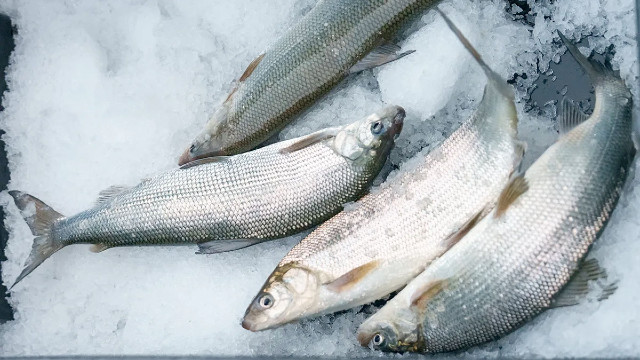By Kelly House
Bridge Michigan
Few things are as synonymous with the Great Lakes as whitefish. They’re central to the Anishinaabe understanding of creation, kept French explorers alive and supported a booming fishing industry for generations.
But in the span of a few decades, populations have crashed in lakes Michigan and Huron. After freighters brought European mussels to the lakes in the 1980s, thriving ecosystems became deserts.
The hungry mussels now blanket the lakebeds from coast to coast, where they have siphoned away the nutrients and plankton, leaving behind desolately clear water with precious little food.
The lakes are so transparent that sunlight scorches into their depths, burning baby whitefish alive.
It’s a threat to Michigan’s environment and culture, from Friday night fish fries to summer festivals held in the fish’s honor.
It’s also devastating for commercial fishing families, many of which have spent generations on the water. Some are hanging up their nets for good, while others face a looming decision.
“I figure I’ll give it to the end of this year and see where I’m at,” said Will Ortiz, who fishes out of Fairport in northern Lake Michigan. “I’ll decide in the spring if I want to come back.”
Bridge Michigan has spent four months writing about the whitefish crisis. Here are four takeaways:
Solutions are elusive (and underfunded)
Saving the whitefish requires suppressing the mussels, but now, the infestation is only getting worse.
Scientists see promise in ongoing research to identify pesticides, parasites or genetic vulnerabilities capable of suppressing the shellfish en masse. But those technologies won’t be perfected for years to decades and public funding for research is meager.
The primary federal grant program for Great Lakes science has allocated $14 million since 2010 — less than 4% of the US budget for invasive sea lamprey control and one-ninetieth of the $1.2 billion plan to keep invasive carp out of the lakes.
“It’s really just a drop in the bucket of what’s needed,” said Samantha Tank, who oversees aquatic invasive species efforts for the regional Great Lakes Commission.
A fishing ban may not help
In nearly every other collapsing fishery around the globe, the culprit is overfishing — a problem with an easy regulatory fix.
“You have to tie boats up at the dock,” said Grantly Galland, project director for international fisheries with the Pew Charitable Trusts. The sacrifice pays off when stocks recover.
That’s not the case here.
After decades of lackluster reproduction, many whitefish left in the lakes are now elderly. They’ll soon die of old age if fishers don’t catch them first.
“There’s no regulatory fix for what the problem is,” said Steve Lenart, a fish biologist with the Michigan Department of Natural Resources.
Still, state and tribal regulators have been gradually lowering catch limits, hoping to buy time while researchers figure out how to suppress the mussels.
All-out bans could be coming soon to some areas of the lakes.
There’s one lake still standing
The collapse in the lower lakes — which historically have provided more than 80% of Michigan’s commercial whitefish catch — has prompted more harvest from Lake Superior.
There, whitefish stocks remain healthy because invasive mussels remain scarce. A lack of calcium in the water makes it hard for the bivalves to build their shells and cold water stifles their reproduction.
But there are two catches.
One, Lake Superior’s whitefish stocks have always been small compared to those in lakes Michigan and Huron. The Big Lake is simply incapable of producing enough fish to compensate for the lower lakes’ collapse.
And two, invasive mussels are making inroads in Lake Superior as pleasure boats and shipping freighters spread them from place to place. It’s not yet clear whether they could proliferate enough to cause the kind of damage they’ve inflicted down south.
“We’re insulated, but we’re not immune,” said National Parks Service scientist Lauren Isbell, who does research on Isle Royale.
Bleakness comes with a side of hope
Whitefish aren’t alone in their struggle. In Michigan, 407 species are listed as threatened or endangered, while a dearth of data may doom others to fade away unnoticed.
It’s part of a global extinction crisis caused by sprawling development, pollution, climate change and the spread of invasive species that has put more than 1 million species at risk. More losses are likely unless humans change their ways.
“We can’t just do what we’ve been doing for the last 100 years and expect things to change,” said Michael Monfils, director of the Michigan Natural Features Inventory.
The good news is, scientists are getting good at last-ditch rescue efforts. Some have begun to pitch one for whitefish.
Think of it like Noah’s Ark for fish. A small number would be relocated to inland ponds or small lakes, where they would remain indefinitely until the Great Lakes mussel invasion subsides.
“We need to make sure that, 20 years from now, if the lake is ready again, we can return the descendants of fish that came from here,” said Jason Smith, a scientist with the Bay Mills Indian Community.
Ponds already offer plenty of food and shelter for fish, making them a cheaper and more humane alternative to raising whitefish in the cramped concrete raceways of a fish hatchery.
Such extreme-sounding species preservation efforts are growing commonplace as humans push nature to the brink. Around the world, nonprofits and governments are cryogenically freezing endangered animals’ DNA, establishing massive seed libraries and even cloning rare animals to stave off inbreeding.











